
Two official postcards issued on the occasion of the Twelfth Zionist Congress - held in Karlsbad in 1921.
* A Jew in a tallit holding a Torah scroll, a painting by Yaakov Steinhart, signed in print. Not mailed. Rimmer Catalog No. 37.
* 'Not by force nor by power but by my spirit' - suffering and hope. A painting by Josef Budko depicting the Jew suffering in exile in the face of the growth of redemption. Signed with an official postage stamp of the Congress, sent by mail in 1921. Rimmer No. 38.
Few stains. Good condition.
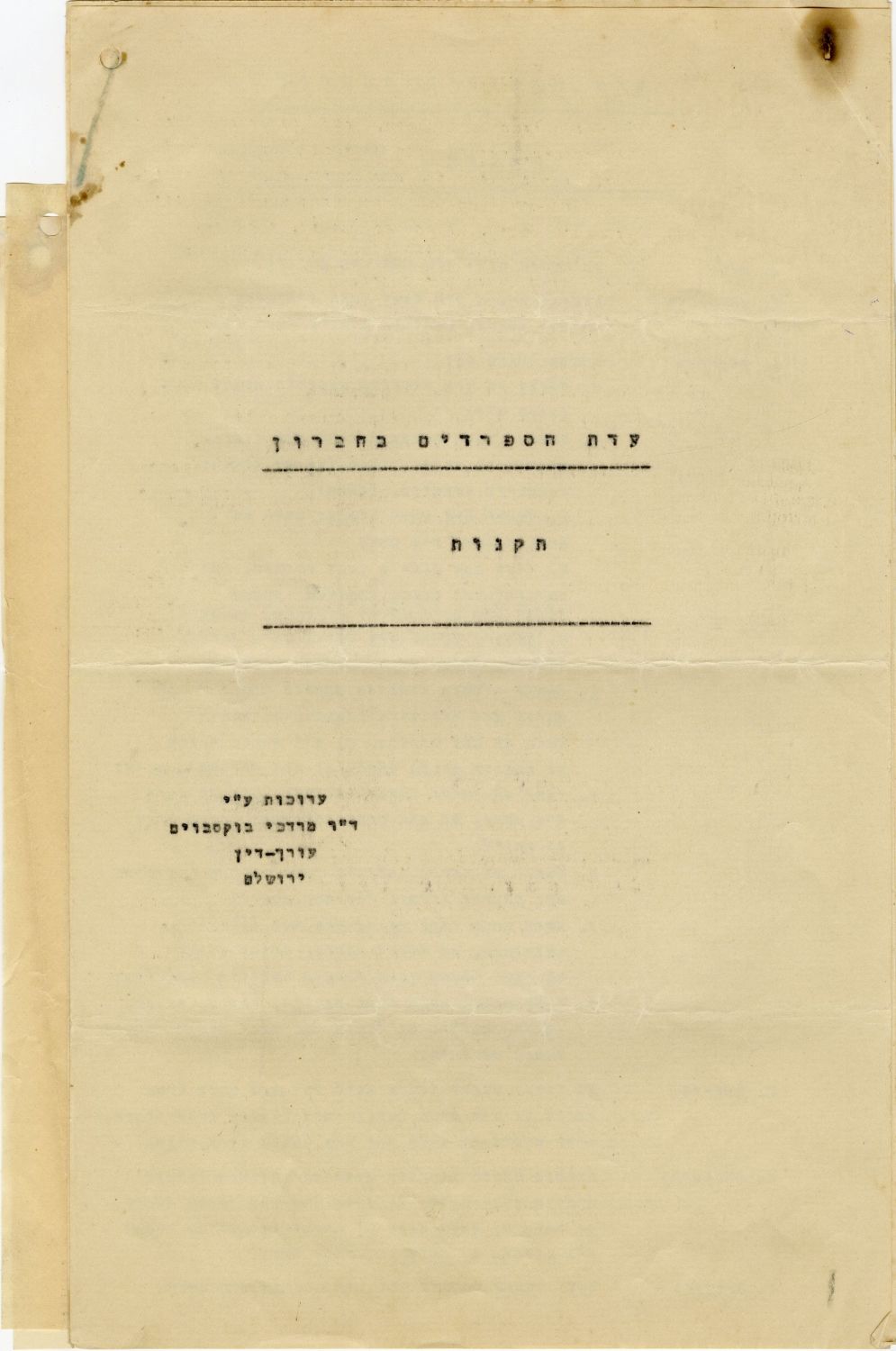
The regulations of the Sephardic community in Hebron - Shvat new moon 1937. Typewriting. Written and amended while there was not a single Jewish person left in the city of Hebron!
Among the regulations that appear: "The company's Palterin is temporarily in Jerusalem and will be transferred to Hebron when the Jewish community returns there, the company's goals are: ... to return to the Hebron community refugees who left due to time constraints and provide them with all their spiritual and religious needs . to elect a chief rabbi and reorganize the rabbinate and courts of justice ... to preserve the graves of the saints and other holy places in Hebron ... The members: Every Sephardic Jew over the age of 18 who is a resident of Hebron or was a resident of Hebron can be accepted as a member of society ... Once a year a general meeting of the company will convene ... ".
In 1927, the Ashkenazi and Sephardic communities were represented on a committee called the "General Committee of the United Hebrew Community in Hebron." The committee was chaired by Rabbi Meir Shmuel Kashmir and Rabbi Yaakov Yosef Slonim. The Av Beit HaDin of the last Sephardic community in Hebron until the riots of 1929 was the saint Rabbi Hanoch Hasson [1867-1929]. In the riots of 1929, Rabbi Hasson and his wife Clara were murdered in their home during the Hebron massacre. Three days after the massacre, the British authorities decided to eliminate the Jewish community in Hebron. The remains of the Jewish community in Hebron were moved to Jerusalem. The houses of the Jews were looted by the rioters. The Hadassah House was converted by the Arabs of Hebron into a girls' school, the Avraham Avinu synagogue was destroyed and a goat shed was built on it. The ancient Jewish cemetery was also desecrated and destroyed. The Jewish settlement in Hebron was renewed for a time in 1930 by 36 Sephardic families numbering about one hundred and sixty people. With the outbreak of the Great Arab Revolt in 1936 (the events of 1936-1939), the last Jews left the city (except for one family). In the specification of the regulations before us, a first attempt was made to return the Sephardic community to the city in the form of regulations for the future, when the Sephardic settlement returned to the city, which actually took place only after its re-occupation in the 1967 Six Day War.
[7] leaves. 33 cm. Good - very good condition.

"... Killed during the riots in Hebron on August 24, 1929, in accordance with the law we demand the ransom of the killed ..." - folder containing dozens of stencil and handwritten documents filed as a lawsuit against the Palestinian government for the victims of the 1929 riots in Hebron about a month after the riots, including details about the murdered and robbed, estimated damage to life and property, and the amount of compensation required. Among other: signed documents by the heads of the American Consulate regarding claims for damages from American relatives of the pogrom victims, and more. A lawyer folder full of unknown documents of paramount historical importance that appears here for the first time.
The first documents deal with the Ottoman law on compensation for the murdered, and regulations on claims for stolen property, below are some documents from the American Consulate regarding compensation claims against the Palestinian government for losses incurred by American plaintiffs during the 1929 riots, including lists of names of the victims and the estimate of the damage, signed by the American Consul. There are leaves with the names of "robbers" and "killed" in handwriting and typewriter, which include the amount of compensation claimed by the Palestinian government for them, and pages in which there is an exchange between the American consulate and the lawyer who handled the lawsuits. There are also nine leaves of a lawsuit entitled: "1929 riots - a claim for compensation." on each page the name of the plaintiff - usually a relative of the murdered person, and details about the murdered person, how he was killed, details of the objects looted by the Arab rioters - when exactly they were bought, their color and size. In them: Compensation claim sheet for murdered people who stayed at the house of the Rabbi of Hebron Elazar Dan Slonim - Yaakov Wexler and Rabbi Zeev Berman: "Place of damage: Beit Eliezer Dan Slonim Hebron, damaged by: Arab murderers, Rabbi Zeev Berman was killed during the riots in Hebron on August 24, 1929, according to the law we demand the ransom of the person killed", There are also three leaves of lawsuits for the families of those murdered at the Bezalel Lazarovsky House in Hebron, a lawsuit for those murdered at the Nachman Segal House, the Zvi Yosef Kidlstein House, a ransom lawsuit for the murdered Avraham Shapira, and a robbery lawsuit filed by Yaakov Meir Bernstein, whose family members were robbed.
[58] leaves. Folder: 35 cm. general condition good - very good.
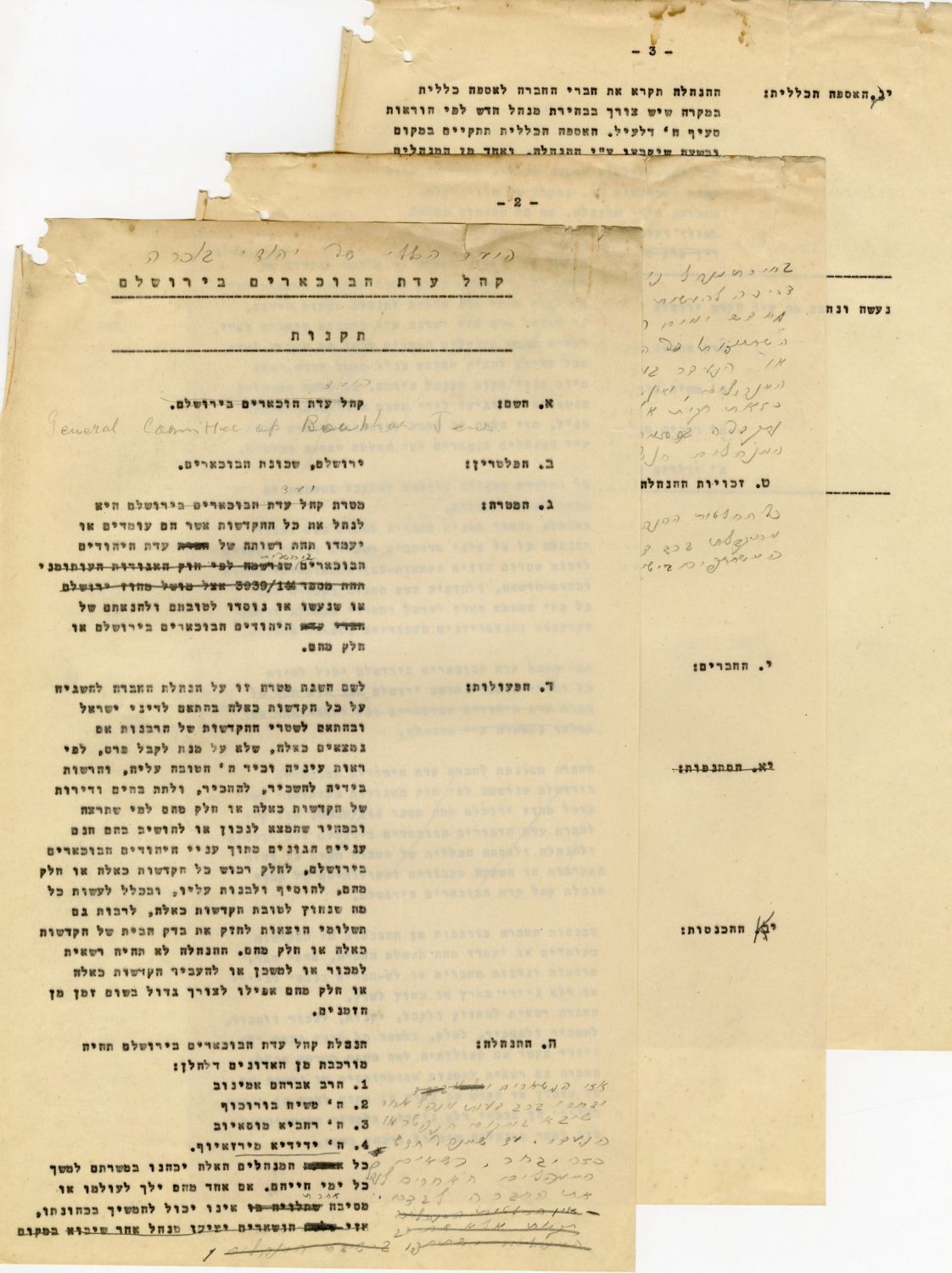
"The purpose of the Bukharan community in Jerusalem is to administer all the "Hekdashot" that are or will be at the disposal of the Bukharan Jewish community member registered under the Ottoman Associations Law ... with the Governor of the Jerusalem District ... were founded for the benefit of the members of the Bukharan Jewish community in Jerusalem or part of them ..." - Regulations and drafts of regulations established by the heads of the Bukharan community in Jerusalem: Rabbi Avraham Aminov (Rabbi and leader of the Bukharian community in Jerusalem until his death in 1929) , Moshiach Borchof (Jewish-Bukharian merchant and activist in Jerusalem. One of the founders and director of the Sphardic Orphanage and a delegate of the First Assembly) , Rehavia Musayov (Jewelry merchant born in Jerusalem, father of the famous multi-millionaire Shlomo Musayov) , and Yedidya Mirzayev (signed in print) The 1920s and 1930s. An important collection of early documents concerning the dedications of the Bukharan community in Jerusalem. Typewriter printing.
Preliminary regulations that have not yet been published, That intended to regulate the status of Hekdeshot - the buildings of the community dedicated by the previous generationsin, accordance with Torat Israel. Among other things, it was determined that allowed the committee to sit in the Hekdeshot for free the poor of Bukharian Jewry while emphasizing: "The management shall not be entitled to sell or mortgage or transfer such deductions or part there of even for a great need at any time of the times" . In addition, the names of the heads of management were determined (the names above), and it was emphasized that they will be in charge for the rest of their lives, regulations regulating the company's income, meetings, and more appear. In addition, there is a document submitted to the Jerusalem District Commissioner in the month of Av 1929 requesting a change in some of the regulations signed (in print) by the heads of the Bukharan community, as well as a document 'declaring the creation of a society' approving the dedication committee as a registered member from August 1929. and additional documents on behalf of the Palestinian government in this matter, and more.
The life of the "Rehovot" neighborhood, now known as the "Bukharim Streets", was supervised by the neighborhood committee headed by Rabbi Avraham Aminov. The committee won the support of local government institutions and enjoyed great prestige among members of the community in Eretz Israel and abroad, the committee's activities were broad and provided for all the needs of the residents.
In the late 19th and early 20th centuries, the committee worked extensively to build the neighborhood and its institutions. During this period, luxury buildings were built in the neighborhood, including the "Palace", the Davidoff House (which served as the residence of the Hebrew Gymnasium), the Moshhioff House (which was the largest house in the neighborhood, about five dunams in area), the Simchioff House and more. In order to enable even members of the community with little ability to live in the neighborhood, 25 apartment houses were built which were a kind of "housing" and their price was lower than the price of a private house. A courtyard was also established in the center of the neighborhood, which was built entirely with money from the Hekdesh and which housed five synagogues, yeshivas, a Talmud Torah of the community and a large cistern that served the many residents of the courtyard. The committee took care of paving roads and planting trees in the neighborhood, which to this day is one of the most glorious neighborhoods in Jerusalem and in Israel in general.
[40] leaves. Data in the original folder from the 1930s. the regulations appear in several copies in almost the same wording with different handwritten or printed corrections in each document. general condition very good.

Three documents claiming the return of plundered land, submitted to the Ministry to register foreign claims - on Jewish lands plundered during the War of Independence 1949 and 1953.
* prosecution document for a residential house consisting of a large yard (100 square meters) and two swimming pools flowing into it, and the buildings around 12/10/1949. The house is located in Damascus, in the Jewish Quarter at 38 Al-Jimaa Street. Owner: Inheritance of Jacob Laniado. The plaintiffs: "The brothers David and Yosef Laniado" - the sons of Yaakov Laniado. Defendant State: Syria. In the comments below: "This property was handed over by us to one of the tenants and his name is: Samri Smaka (Jewish) from about six or seven years ago. When the war broke out, we did not receive any further information from the next force or from what was done in the house ...". The current condition of the house: "Jewish and Armenian tenants live in it, and we do not receive any wages from them ...".
* prosecution document on the land of 'Miri' in the village of Bir Nabalala dated 7/23/1949: Kerem Isark. Prosecutor: David Wiesenstern. Defendant State: "The territory of the Land of Israel subject to the rule of the Arab Legion."
* prosecution document on the same land about three years later on 10/29/1953. Prosecutor: David Wiesenstern. Defendant State: "Government of Jordan."
[3] Printed documents handwritten by the Prosecutors. Same size: 44x33 cm. Stains, good condition.

4 rare propaganda posters on behalf of the JNF in Strasbourg, describing the activities of the JNF and calling for joining its large factory in donation and activity, and a card calling for joining the JNF's blue box factory in Strasbourg. French.
The posters are accompanied by photographs from the Zionist enterprise in Eretz Israel, one of the posters is written in Yiddish and French.
On the back of the poster, handwritten inscription from the period of printing.
4 posters same size: 27x22 cm. The size of the 'Blue Box' card is 14x10 cm. Very good condition.
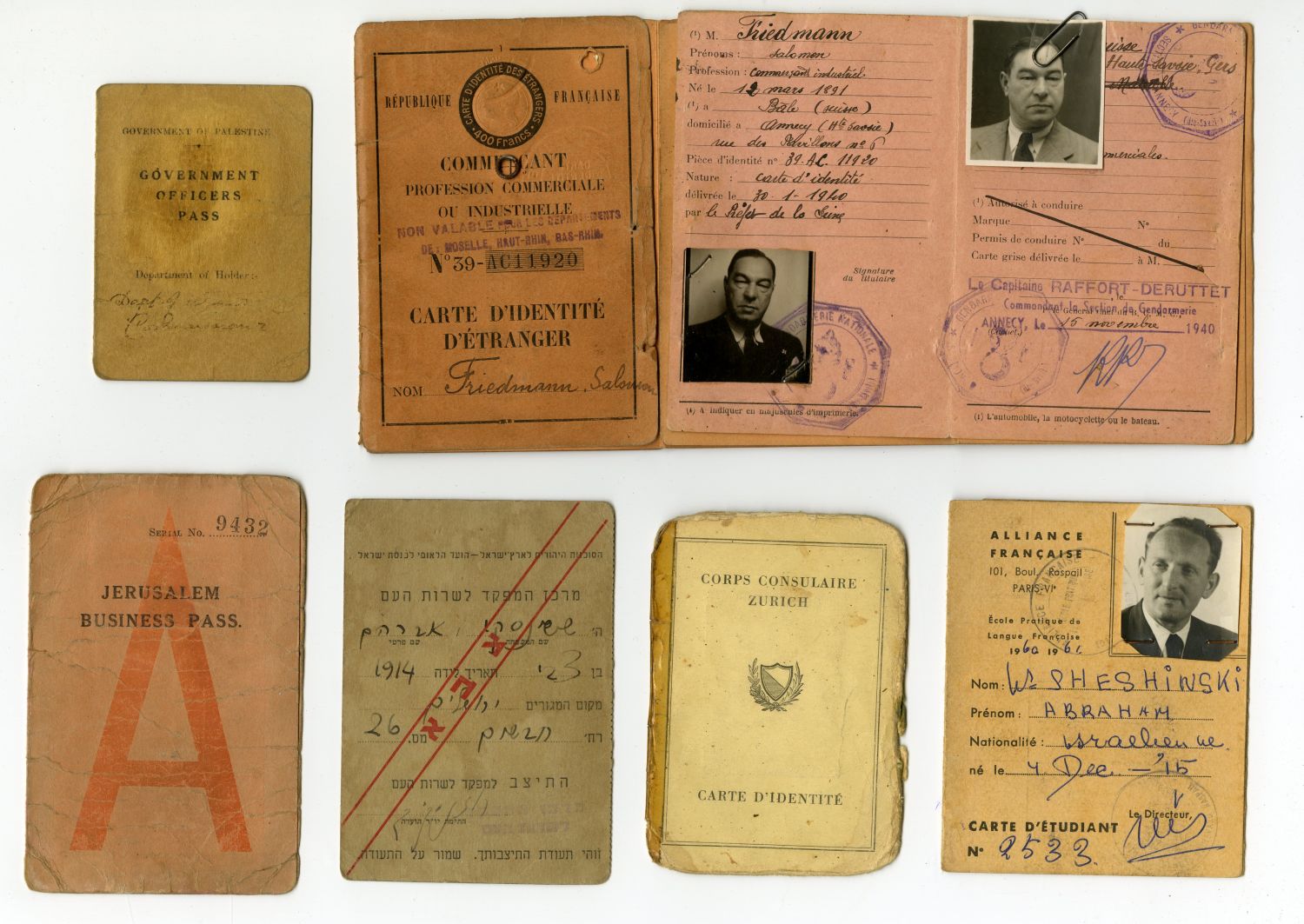
36 various personal books of Jews, identity cards, temporary certificates, membership books, and account books. Eastern Europe, Eastern countries, and Eretz Israel. The first decades of the 20th century.
Among them: Loan and Savings notebooks and Anglo-Palestine Bank account booklets, Permission to stay outside a soldier's camp in the "General Transport Unit" of the Jewish Brigade, personal notebooks of Jews in Bulgaria, membership cards of Jews in the 1900 elementary school union in Ukraine, Membership cards in a social internship course in Russia, membership card of a Jewish soldier in the USSR 1919, student card in a Jewish school in France, ID card of a Jew - Zurich, ID card of the Census Center for Public Service, government employee card in Palestine, notebook for Polish soldier 1909, transit card Border Haifa 1938, Jewish worker register in the service of an oil company in Iraq 1936, membership card in the Austrian Industrial Workers' Union 1932, personal cards of Jews from Kurdistan (including transit cards), and more.
Not thoroughly tested.
Overall good-very good condition.

8 photographs and 15 letters sent in postcards of a Jewish soldier named Yaakov Cohen who served in the German army during WWI.
In the photos: group photos of him and his comrades, in treatment at a military hospital after an injury, and two photos of Cohen from a younger age before enlisting in the army. Postcards sent while he was in the hospital, postcards sent to his family from Frankfurt, and other places between 1915 and 1919. The contents of the letters have not been thoroughly examined by us.
general condition very good .

A prayer leaf printed on behalf of the Adat Yisrael Synagogue in Berlin - 'Save our Lord the King, the Emperor, save our people and save our country' - a special prayer text to rescue from the enemies in the First World War. Hebrew and German. rare.
below is the address of the synagogue which has been located at 31 Artillerystrasse Street since 1904.
Size: 23x15 cm. Folding marks. Good condition.

A special miniature prayer order for the overthrow of the enemies during the War of Independence. "The virtue from an old manuscript kabalah from man to man until Moshe Rabbeinu Zia'a to fight with the enemies and defeat them and casualties fell before Bnei Yaakov and this is the order...", on the front and back cover printed the Israeli flag. Without specifying a year of printing. In the National Library, it is dated to the year 1948 according to Gershom Shalom. And in a comment there, Gershom Shalom was quoted as saying: "1948, given to soldiers in Jerusalem. A virtue for the soldiers of the war - a collection of prayers and verses given to the soldiers in Jerusalem". in the copy before us on the other side of the cover, an owner's listing 'Jacob Orenstein' and the date Mai 4,1948" (The second phase of the War of Independence, in the midst of an attack by the Haganah forces on large areas in the coastal area, the Galilee and the Jerusalem Corridor).
On the first page is an illustration of Rachel's tomb. In the special 'Seder' was printed 'Vayehi Noam', 'Lecha Hashem HaGadulah', names of angels and prayer for the overthrow of the enemy: "אשאל השאלה הזאת מלפני עלת כל העלות ברוך הוא וברוך שמו שתצילני מהאויב הרע הזה ומאנשי הצבא שלו ויפלו חללים חללים ותשליך אימה וחשיכה גדולה ותרדמה עצומה ובהלה ושגעון ועורון ותמהון לבב על כל אויבינו... תצילנו מהפצצות והיריות של האויב ומהריסת בתים...ונחזור לבתינו לחיים טובים ולשלום", and various verses to overthrow the enemies.
8 pages, 8.5 cm. Stains on cover. Good condition.

Map of the battles of the War of Independence' - A complete set that includes 29 maps describing the battles of the War of Independence - worked, drawn and edited by the branch of history at the General Staff. Printed by the Government Surveying House. April 1954. Limited edition of only 100 copies. The edition before us was dedicated to the Chief of the Military Intelligence chief, General Benjamin Ghibli.
29 maps depicting the moves of the ground forces in the various cities of Israel during the War of Independence. Each map describes the location and course of the various divisions that operated in the war with special markings for 'occupied', 'defensive action', 'raid', 'encounter', 'temporary occupation', and 'seizure without battle', the exact location and date. In 1954, the History Branch of the General Staff published this edition, which includes 29 detailed maps divided according to the various sections of the war in Israeli cities (each map depicts a different city, or region), in a limited edition of only 100 copies. The copy Before us was given as a gift to the head of the Intelligence Division, General Benjamin Ghibli, who took up his post that year, with a special dedication in the cover lining.
Benjamin Ghibli [1919-2008]: Before the establishment of the state between 1944 and 1948, he served in the Jewish localities police and was active in the SHI service. Upon the establishment of the State of Israel, he was appointed intelligence officer of the Jerusalem District. In early 1949 he was appointed commander of the Intelligence Branch 1 which included combat intelligence and research units. In June of that year he was appointed deputy head of the intelligence service. In 1950, he was appointed head of the Intelligence Department at the General Staff. After a period of study abroad, he was appointed head of the Intelligence Division at the end of March 1954, with the rank of colonel. In his capacity as head of the Intelligence Division, he was responsible for recruiting and operating a squad of Jews in Egypt by Unit 131. The squad was captured in July 1954, a matter later known as the "Essek HaBish". For many years Gibley's identity was hidden in this context, and he was known only as the "senior officer."
Total 29 maps - Complete set. Scale 1: 100,000. Same size: 50X70 cm. Stains on cover. The maps are in very good condition.
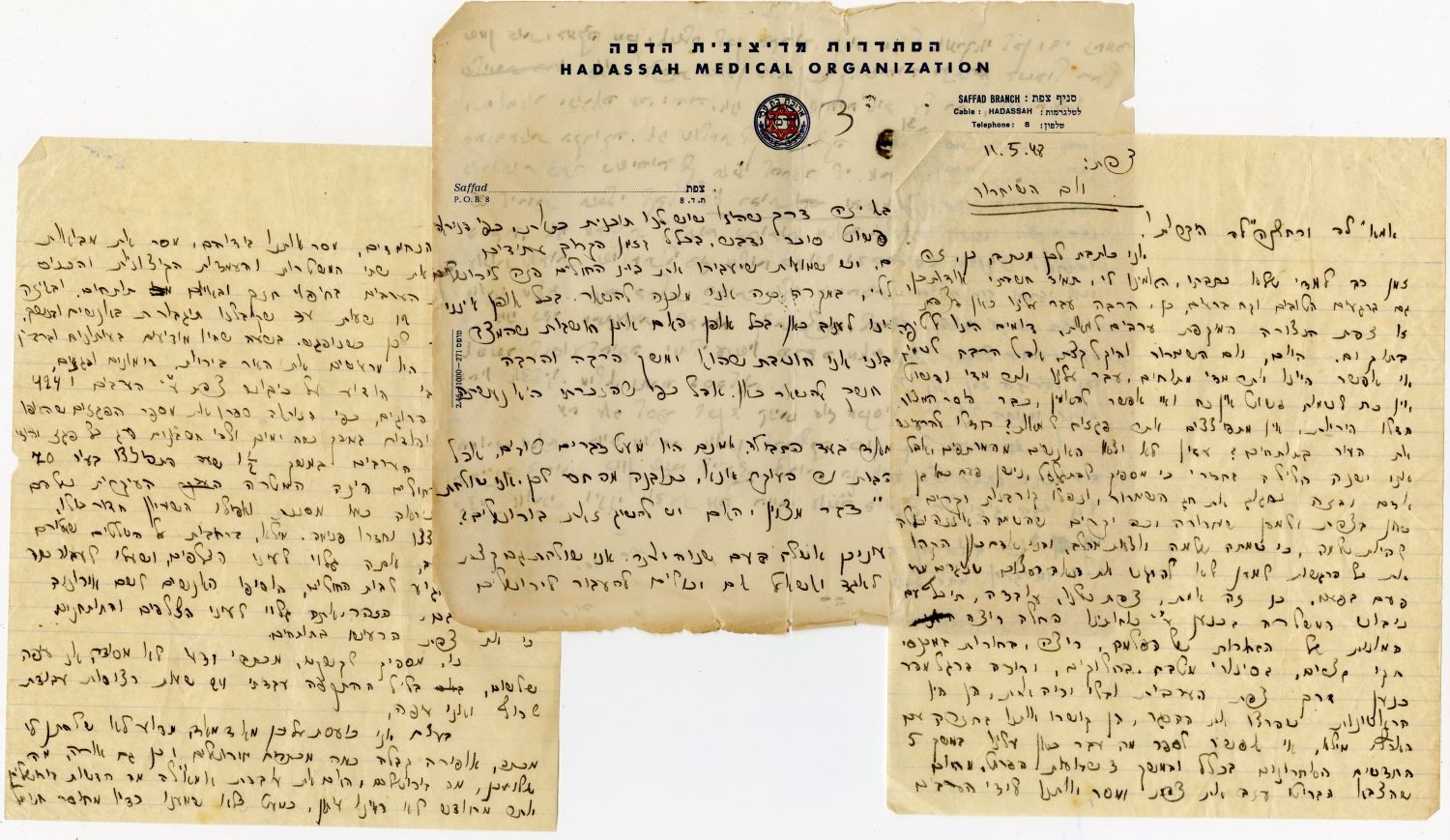
A huge collection of about 400 letters written between members of one family and saved, during the War of Independence in the years 1947 to the end of 1948 - the war and the liberation. Many letters were written by a nurse at the Hadassah Medical Association, Safed branch, known as Rahelka, describing the Safed front, as well as letters from family members who were at the time in Zichron Yaacov, Jerusalem and Haifa, describing the events of the war, the Arab attacks, the fallen, the fear of harm, The victory and joy in the streets and more.
In her letters, the nurse describes, among other things, the course of the battles of the War of Independence, and in particular the details of what happened in Safed during the battles. The letters describe the shooting attacks on Safed, the lack of food, the rumors of the relocation of the hospital to Jerusalem, the recruits who did not know what happened to them during the war [for example, a letter from June 48 reads: We are very worried about you ... We are very much looking forward to the sign of life from you and from rdelka, and I hope we will receive the sign soon ..." ], and in recent letters, the victory and the lifting of the siege on the city of Safed.
A letter dated 12/1/47 reads: "Congratulations, Hebrew state, finally ... We said goodbye without knowing that in an hour will be announced on the Hebrew state ... We returned home at 5:30 in the morning, the streets were full of people and beer and wines were distributed in abundance." A letter dated 5/11/1948 entitled "Safed: Liberation Day" reads: "A lot has happened to us here in Safed, this is besieged Safed surrounded by hundreds of Arabs, we were like a drop in the ocean. Today, the day of liberation and a little relieved, but much to rejoice is impossible ... There is no power and it is unbelievable that the siege has already been lifted, the shootings have stopped ... the people have not yet come out of the cellars ... Dear victims have fallen here in Safed and for its liberation, and so precious that joy can not be complete ... People here have dulled all emotions. .. Safed belongs to us it's a fact ... without a single shot ... in what situation we were 12 hours until we received reinforcements in people and weapons all this I will tell you when we met, while they were announcing in the newspapers and radio in "Safed is quiet", the city would be shot, grenades and shells, Arab radio Announced the conquest of Safed by the Arabs, 4241 Jews killed, apparently counted the number of shells that flew over the Jewish quarter for several days, and according to their account every shell single killed one Jewish ... ".
Letters written in Jerusalem during the War of Independence from the same family also describe the difficult events. For example, a letter from June 1948 reads : "You want to hear what happened to us, a somewhat difficult demand because who can describe it ... The last letter I received from you was shortly before the fall of Judah, so we were still complacent, stupid, or just plain innocent and we believed in "there will be good". Judah's death was in fact the first attempt of the cruel fate to put us face to face with the reality we were so afraid of ... we were amazed, we fell in our spirit, we almost gave up ... after two or three weeks we got used to it too, there was a friend - And no more! ... The front was still far away, we could still watch during the battles from "far" until the first shell fell next to us, right next to us, so we forgot Galilee and Negev, so we did not remember victims from Nabi Yehoshua and Negba, we saw people fall next to us , In our 4. Amot. We saw people with limbs amputated and crushed without knowing in the streets, on the sidewalks, on the roads we had to walk every day on the way to work and home ... the attack on Jerusalem came too early, even before we managed to recover from the fall of Gush Etzion, can you imagine for a moment what a falling bloc is? A block of 4 settlement points, containing about 400 isolated and detached fighters from everything, cries out for help and there is no ... we knew that none of the defenders of Kfar Etzion remained, of the other three kibbutzim few were taken captive, among them Benjamin Duvshani, whose brother Yehuda fell and he himself miraculously survived ... ".
A letter written in Haifa on April 16, 1948 reads: "Today I woke up to the voice announcing a curfew in Har and Hadar Carmel , and only later did I learn through the radio that the curfew was imposed due to the execution of four Israeli boys. The situation in Israel will be even worse ... tell it to her in Jerusalem ... The Greek and Roman Babylonians did more than those, they even moved a plow over the Temple Mount, desecrated and destroyed our temple, and changed its name to a foreign name. And again Jerusalem recovered and rose again, wrapped in thanksgiving and exclusion ... and may we be the capital and holy city forever! "
Among the letters can be found many with personal content between family describing the attempts to maintain a routine of life despite the fierce battles and the tense situation.
The collection has not been thoroughly reviewed by us. general condition very good
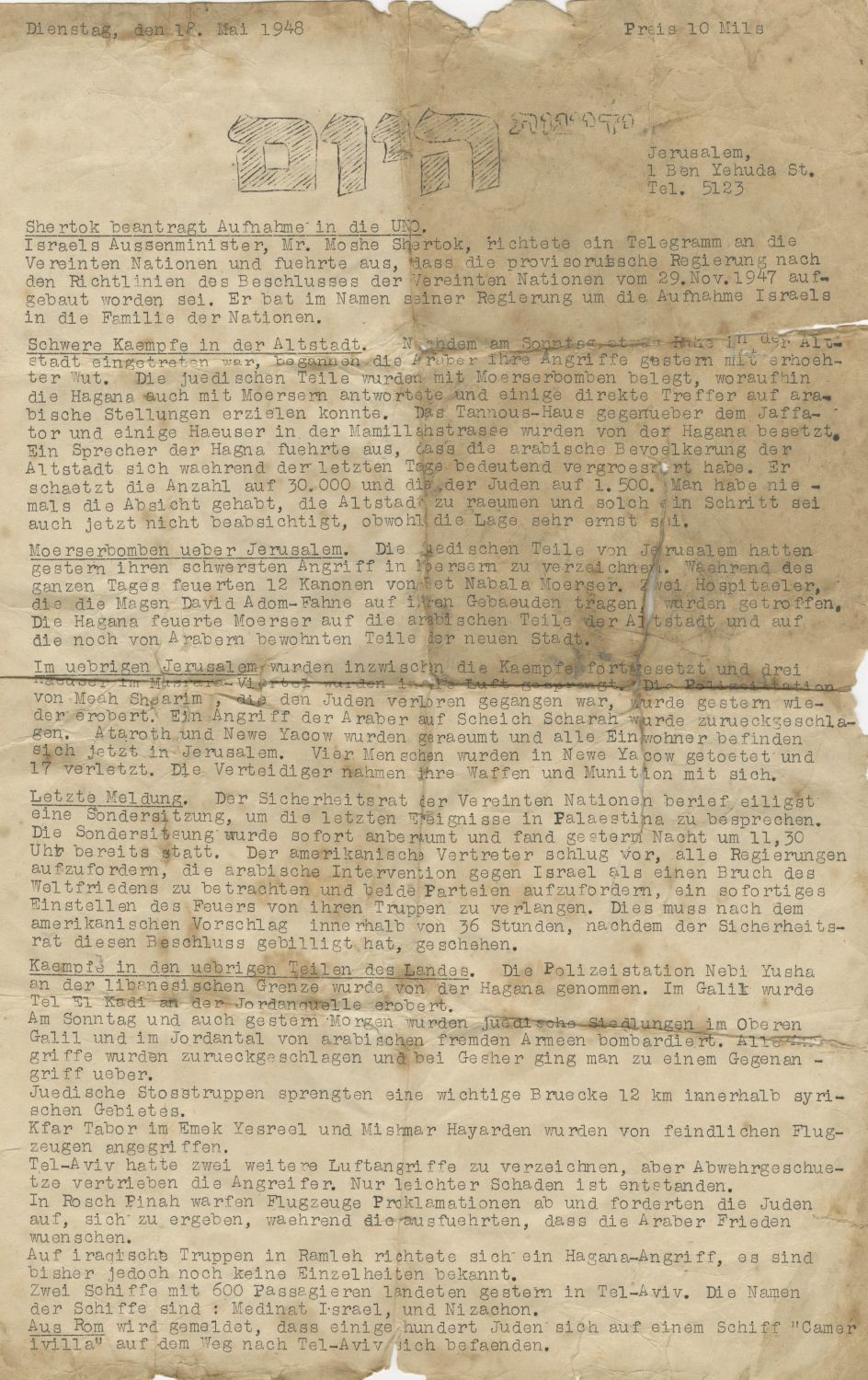
Yedioth Hayom' newspaper - Jerusalem, Ben Yehuda Street. May 18, 1948 - four days after the declaration of independence - reports of the battles of independence in the Jewish Quarter sector of Jerusalem. The headline of the newspaper in Hebrew, the body of the newspaper in German.
The newspaper reports on the Arab Legion's takeover of the Jewish Quarter, and many Arab citizens advancing toward the Jewish Quarter to assist their brothers in its occupation, and that in recent days dozens of mortar shells have been fired in the Quarter area. The newspaper also reports on battles in the Tel Aviv area, and on new uniforms sewn in honor of the Jerusalem police, which is divided into four districts, and that Arab citizens who want to return to their homes in the Jerusalem area can do so with special approval from the Hebrew army authorities. The newspaper also writes that the declaration of a Jewish state has caused countries that opposed it to vote in the UN to recognize it now, and this is to the detriment of the Arabs who are trying to change the established reality. Extremely rare.
[2] p. Typewriter printing. Stains. Tears (restored), folding marks. Good condition.

A collection of c. 80 internal documents in stencil printing that deal with the activities of the Mishmar Ha'am in the Jerusalem sector during the War of Independence. Some are signed by Dr. Amdor, who served as the area's coordinator during the war. All from different months in 1948 (dated), before and after the declaration of independence.
The documents before us deal with: The principles of the Mishmar Ha'am Planning Department as designed on 5/27/1948 - a detailed document dealing with the internal mechanism of the Mishmar Ha'am, appointments of commanders, release of those who needed other positions, activities in the Shaarei Chesed neighborhood in Jerusalem, distribution Positions, 'Ten Commandments for Emergencies', how to guide the public, an important document dated May 16, 1948, which deals with the appointment of Menachem Goldenzel as the intelligence officer of the People's Guard regarding water distribution - signed by the regional coordinator Alexander J. Amdor, an important document dated 10/25/1948, which deals with the urgency of bringing winter blankets to soldiers: "Winter has come and hard prevention is difficult in their ability to stand in battle and in position, every family will feel the sacred duty to set aside from the equipment he has in his apartment or donate a sweater and blanket" - and details of how the collection activity is carried out, Handwritten letters of thanks and congratulations from various operators in the Mishmar Ha'am to Dr. Amdor, who served as coordinator of the Jerusalem sector, and more.
Mishmar Ha'am was a unit of volunteers dedicated to maintaining order in the large cities of Haifa, Tel Aviv and Jerusalem. It was established in Haifa in 1942 by Edmond de Karolik [former cavalry officer in the Polish army], after the threat of occupation by Rommel's armies, Became part of the Haganah's defense. In Jerusalem the organization was established upon the end of the British Mandate in 1947. The unit members were over the age of recruitment, or young people who were not drafted into the army for health reasons. The branches that operated prior to the establishment of the State of Israel were mainly engaged in military defense operations and maintaining order during the shelling.
About 80 documents in total. Data in original folder. general condition very good.

COURS DE JUSTICE CRIMINELLE ET SPECIALE ETAT - A large poster announcing the sentences of the convicts in the French High Court of Criminal Acts - among them punishments for Jews. France, March, 1807, GUICHARD printing - Courts.
Table consisting of: date of detention (March and December 1807), age, residence and occupation of the arrest, place and description of the crime, verdict, the law by which the sentence was imposed, and description of the face of the accused. Among other things described: crimes of burglary, assassination, beating of a forest guard, and others. Among the penalties that appear: monetary fines, imprisonment, and even death sentence. Among the names of the defendants is the Jewish name Joseph Bonnet, who was fined financially, and others.
A particularly rare poster, not appearing in libraries around the world.
Size: 54x43 cm. Folding marks. Good condition.
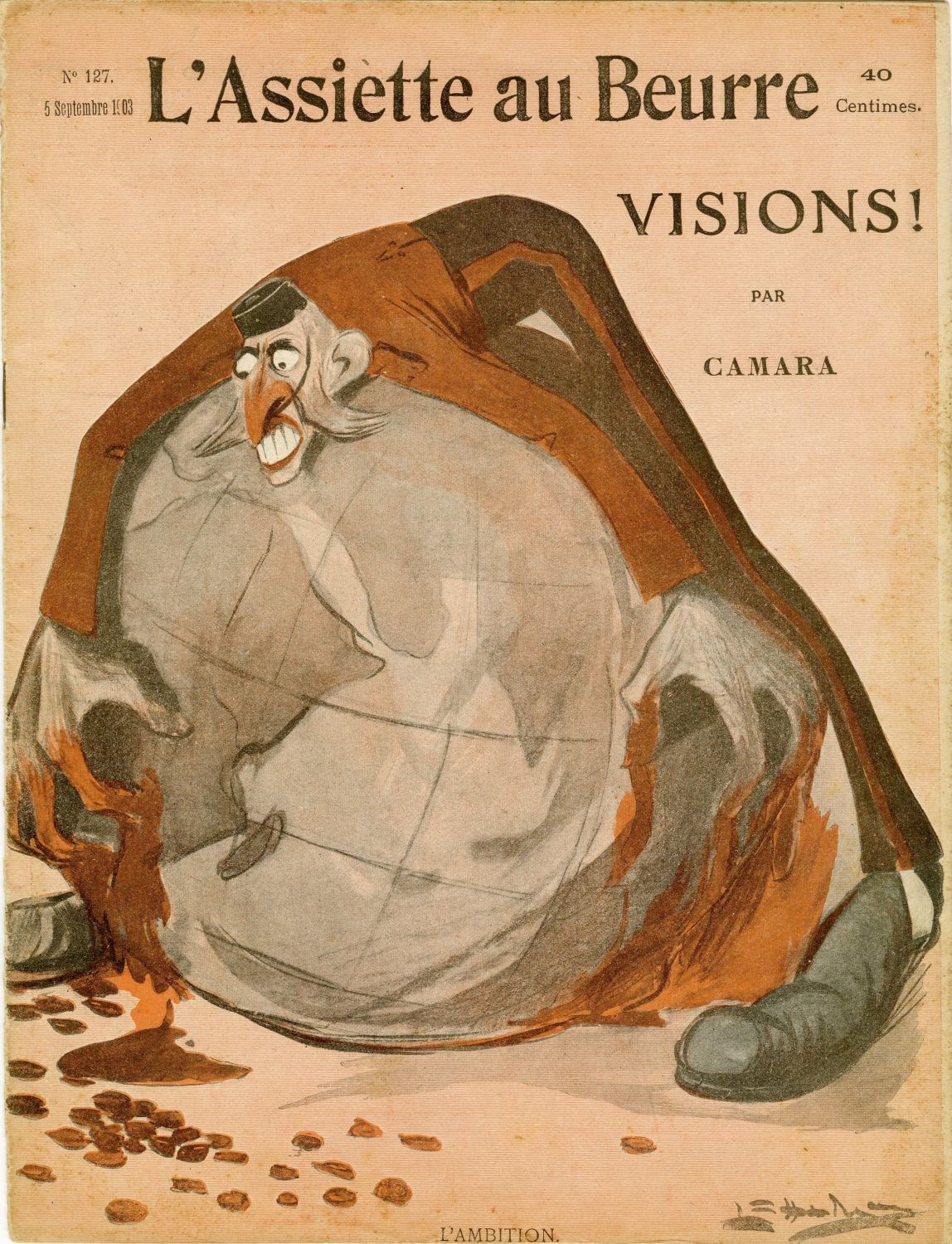
The L'Assiette issue in Beurre visions PAR CAMARA. France, September 1903 (Issue 127). On each page is a large cartoon depicted with a derogatory word at the bottom. On the cover of the issue is a cartoon of a Jew embracing the earth with his blood-dripping arms, and the description: "L'AMBITION - the ambition".
The cartoon in which the Jew appears as a threat to take over the world appeared on various advertising platforms in the 19th century and in the first decades of the 20th century. In 1901, the German 'Kikrikiki' presented a mythological monster in the form of a Jew embracing the earth in his arms. The Nazi campaigners used it to spread Jewish hatred, and the attempt to portray the Jew as threatening to take over the world was repeatedly presented in the Nazi de Stirmer in the form of a Jew wrapping the earth in his arms.
Complete sheet. Each page has a large cartoon over an entire page. Very good condition.

L 'Assiette au Beurre - Two issues - September 1901, and November 1905. Both have large antisemitic illustrations, accompanied by antisemitic captions. The 1901 issue was illustrated by Jean Veber [1864-1928] - a French cartoonist and painter, the cartoons he created are characterized by a full painting all over the page and a rich color.
Large cartoons over whole pages, and over two pages (double).
Whole sheets. In one of the sheets some of the pages are detached. general condition good.

Zola 32 caricatures, by Lebourgeois. E. Bernard edition, Paris 1898, 1st edition.
A full series of 32 colorful cartoons against Emil Zola following his support of Alfred Dreyfus. In the same year in which the cartoons were published, Zola was tried for libel and found guilty, sentenced to a year in prison and fined, he removed from the Legion of Honor and in response escaped to England. (About a year after the charge was allowed to return to France). Zola's own books and testimonials from Dreyfus's trial are used in the cartoons. Among the characters are General Henri who led the campaign against Dreyfus (the same year it became clear that an important document was forged by him and arrested, after admitting the forgery committed suicide in prison), as well as judges. In another cartoon, Zola is seen running away from France with a local soldier chasing him, in another he is shown inside a prison cell with Mice at his feet. Appears a cartoon featuring Zulla beating a drum on it written: "J'Accuse" ["I Blame" -Zola's famous article was published in January of that year], And more.
[32] cartoons. 26.5 cm. Half leather binding with gilt inscription on spine. Very good condition.
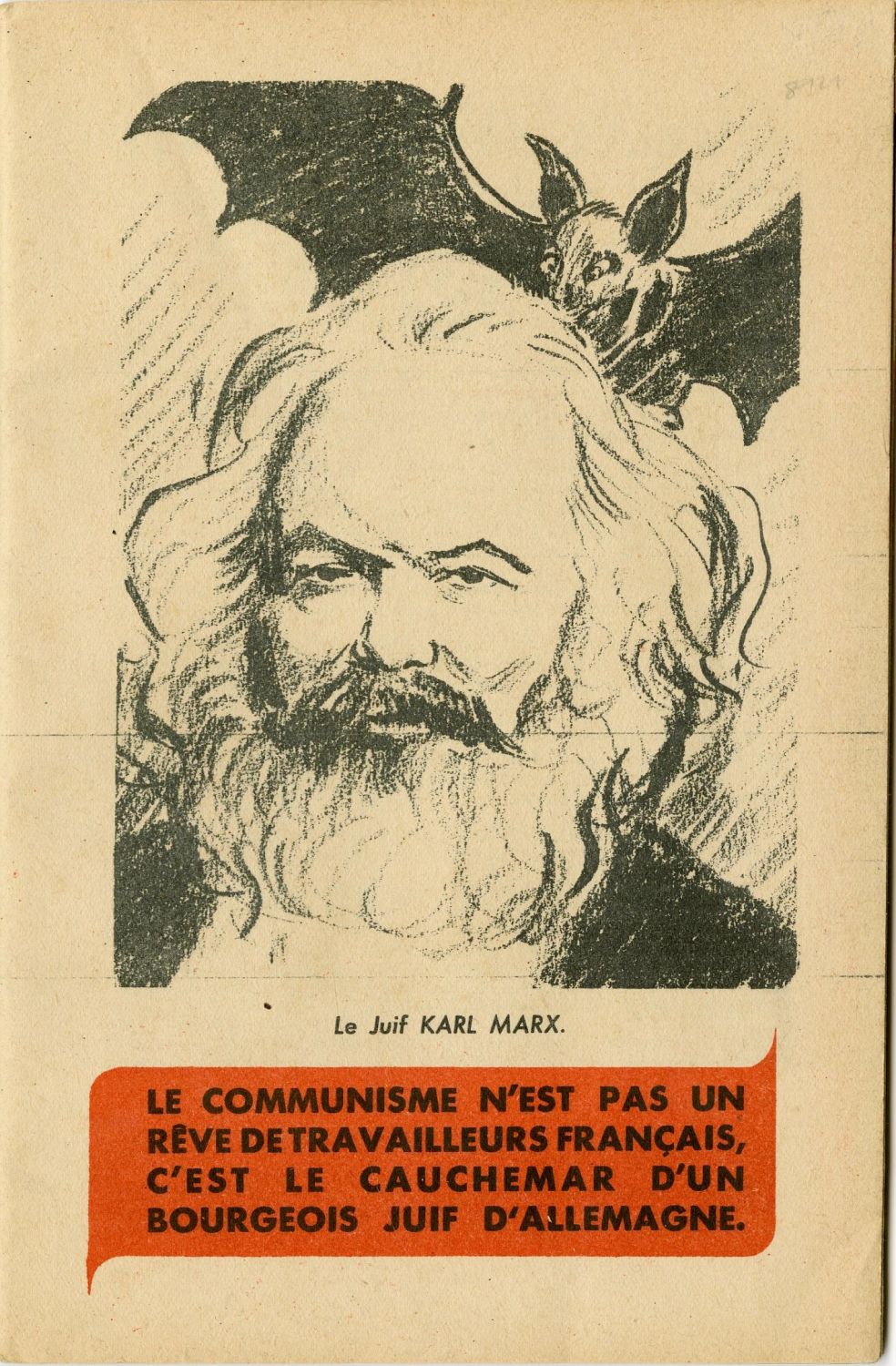
OUVRIER DE CHEZ NOUS REGARDE LIS JUGE ֱ A pamphlet published in France accusing the Jews of trying to introduce communism among French society: "The theory of communism is a lie - a subhuman product of a Jewish mind." On the title page of the booklet is a picture of the Jewish Karl Marx, and the antisemitic caption: "The Jew Karl Marx. Communism is not a French workers' dream, it was invented by Jewish bourgeoisie from Germany", the booklet is accompanied by photographs of famous Jews who support communism. France, early 1930s (no publisher and printer name).
After accusing the Jews of inventing communism, it goes on to detail its disastrous results by exposing communist laws in Russia: Severe warnings to the death penalty for Russian citizens who went out to work outside the country, Soviet tyranny that sent workers violating the laws to Siberia, An employee who is absent from work even for one day is subject to 10 years in prison, Long-term detention of workers found without a Soviet passport, meager monthly wages given to Soviet workers, seven factory workers sleeping in a small 10-square-meter room on the floor, permission for a Soviet officer to use the death penalty against a soldier even without trial, And all these hard things, through the fault of the Jews... There are also photographs of those killed in Russia who were murdered under the auspices of the communist regime, and more.
On the back of the booklet is a drawing of a hand holding a gun and shooting a person, and the caption: "LA SIGNATURE BOLCHEVIQUE" - the Bolshevik signature.
40 p. 21 cm. Very good condition.

A Real-photo postcard of the synagogue scene from the film "The Eternal Jew", captured and photographed by the Nazi propaganda leaders in the Polish ghettos immediately after the Nazi occupation in 1939.
The film "The Eternal Jew, " which Hitler and Goebbels personally directed, was of crucial importance in the Nazi anti-Semitic incitement. The film is intended to remove the so-called disguise from the face of the Jew and present him as the most deadly enemy of the Reich. The film, shot in the ghettos of Poland by the photographers of the propaganda company PK689, presented the 'authentic Jew in his natural environment' - the filth, misery, ugliness, comparison with rats spreading plagues, cunning, greed, laziness inherent in the Jew and xenophobia were presented to the enlightened German viewer as a 'documentary film' that allegedly documents 'The Truth About the Jews'.
The recurring motif in the film was the complete identity of the Jewish subhuman from the Polish ghettos with the Jews of Germany known to the viewer under the guise of a 'civilized German'. At the beginning of the film, the announcer sounds a warning: "The civilized Jew known to us in Germany gives us a little from the character of his race. This film presents true photographs of the Polish ghettos. He shows the Jews as they really are, before they manage to hide behind the mask of the civilized European".
See in detail: Redempion of Ahasuerus, The "Eternal Jew" in Nazi Film, New York, 1991. See also 'Dynasty' Catalog # 7, Item 39.
9x14 cm. Not sent by mail. Very good condition.
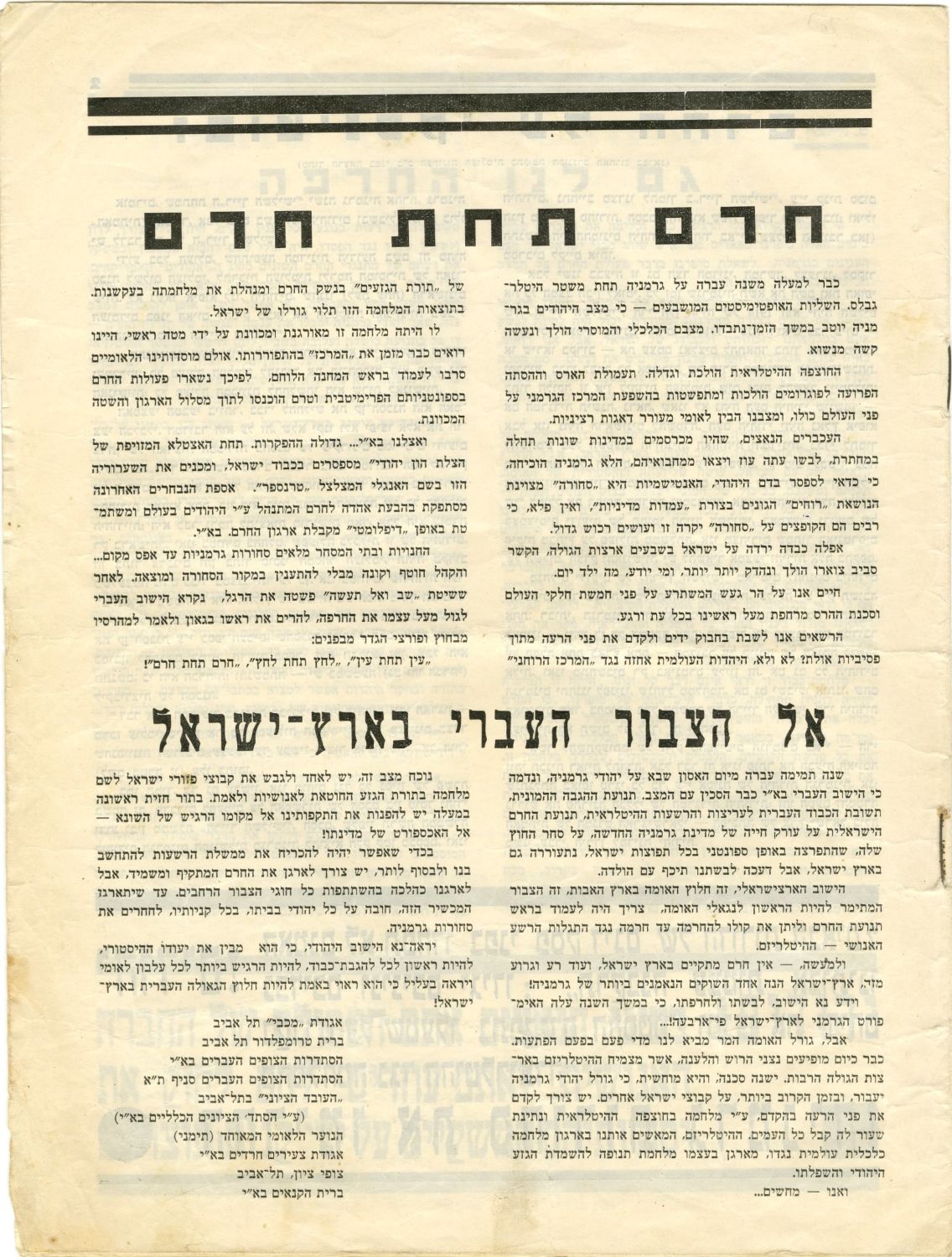
An early propaganda pamphlet with the participation of Zionist associations in Eretz Israel, calling for a boycott of products made in Germany "under the Hitler-Goebbels regime". "Confiscated German goods". Eretz Israel, 1934. (about a year only after Hitler came to power) edit by j. Coland and S. Friedman.
In the booklet, various articles "To the Hebrew public in the Land of Israel" which warn the Jewish public not to purchase German products while the Nazis incite and act against the Jews in Germany: "For over a year now Germany has been under the Hitler-Goebbels regime ... Hitler's impudence is growing ... The propaganda of the venom and the wild incitement to pogroms are spreading ... " . The booklet is full of many slogans such as: "Jews! In the eyes of the Nazis you are the waste of human society, and you help them strengthen their economic foundations by buying their produce" or " the people who violate the boycott will be cursed" etc. The booklet also contains large cartoons and antisemitic articles published in German newspapers in order to inform the Jewish residents of Israel of the magnitude of Nazi hatred and satanism. At the end of the booklet, a long list of merchants who signed declarations to boycott German products.
As far as we know this is the first boycott ever published against German products. Very rare, does not appear in the National Library.
Attached: Two leaflets 'Young Hebrew!' Applying to a young Hebrew man to enlist against the Nazi enemy: "There is no limit to the lust for murder of the Nazi beast... and you are a young Hebrew man! ... Can you close your ears to the cry of your slain and robbed brothers? Every man with whom his honor and conscience went out to fight the forces of death and Nazi impurity ... ". ... "
20 p. Some pages have stains, general condition good.

"Jew! You are going to see a German film and desecrate the memory of the saints and heroes! Boycott the amusement of the German murderers! Do not set foot in a place where a German film is shown! Remember what the German Amalek did to you!" Eretz Israel, 1940s.
A joint poster for four organizations: The Partisans and Ghetto Rebels and Underground Fighters, the Nazi War Disabled People's Organization, a national organization of former Nazi prisoners, the Overseas Soldiers' Organization who fought against the Nazi army and their allies, urging the public not to go see a German film. At the top of the poster is the famous photograph showing the Warsaw ghetto rebels captured by the Nazis, below it, a photograph of Jewish corpses of Jews murdered by the Germans. a black frame.
Very rare, does not appear in the Ephemera collection in the National Library.
Size: 34x18 cm. Stains and minor tears. Good condition.
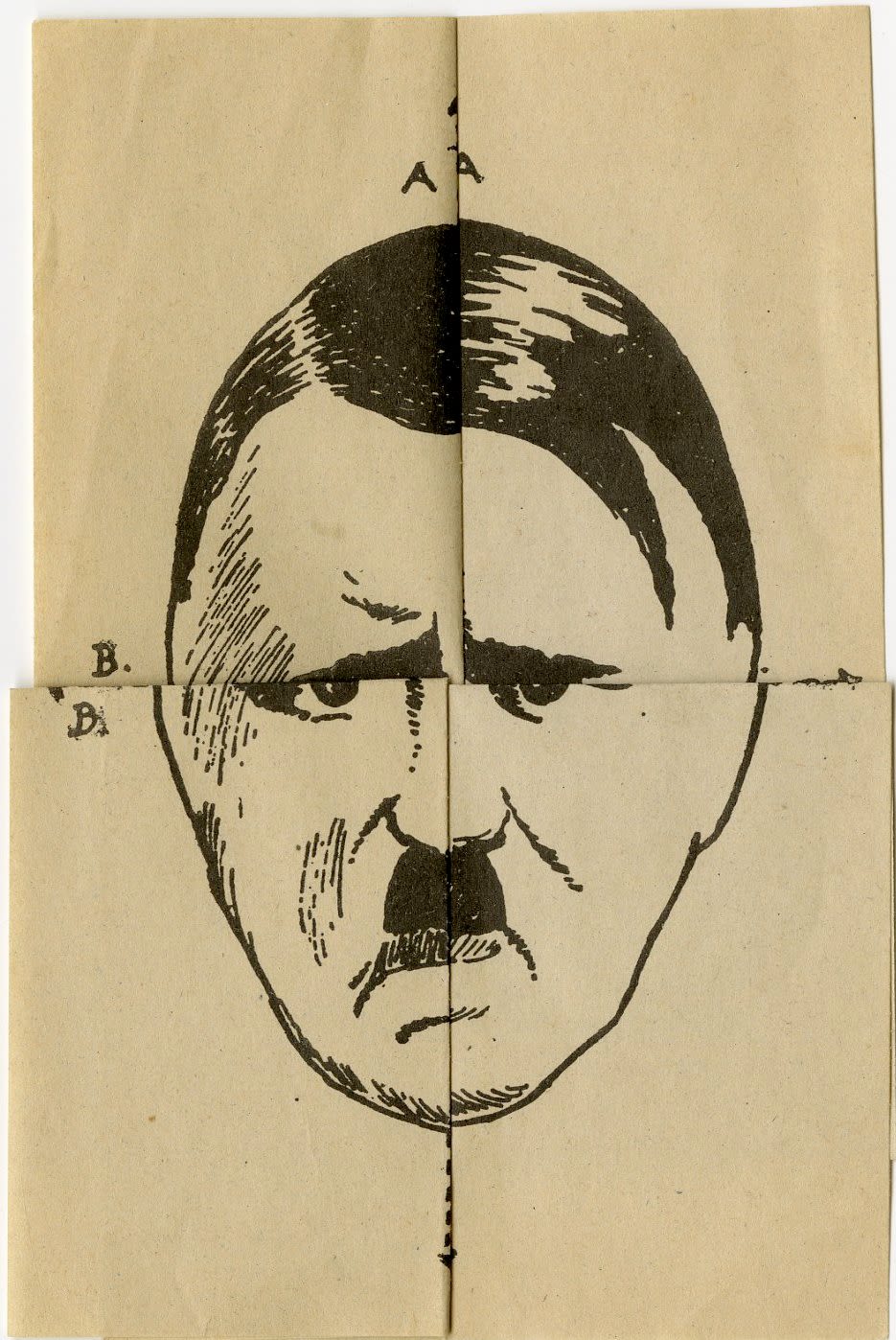
Sheet of paper with a drawing of four pigs. In the center is the caption: "To find a fifth one fold as indicated", When folding the paper according to the markings you see Hitler's face.
Size: 23x16 [open]. Very good condition.

Back at the FRONT Written and illustrated by PETER ENDER [England, midst of World War II] .
A children's book describing Hitler's defeat on various fronts against the Allies, as well as mocking the Germans' lack of knowledge in the management of military systems. Written in a humorous tone, accompanied by cartoons against Hitler, Goering, Rudolf Hess, and the German Reich in general ["Hitler became concerned and the situation decided to come out without a mustache"]. The book was written at the end of the war, when the thunder of the cannons was still echoed and while Hitler was still alive, and in its last pages the author writes:
"Our plane hits the heart of Germany .... to eliminate the German and the Italians regimes, may still have a hard way ... remember that victory is near, it will come one day ... maybe in five months, or maybe in five years ... until that day we will see In the shelter ... ". At the beginning of the book is a dictionary of German war words for the words that the author used in the book.
56 p. Slight tears in spine. Good condition.
Created and Develop with 🤍By webe ©2024